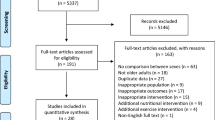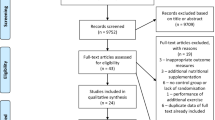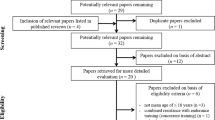Abstract
Background
Resistance training is an effective way to enhance strength in female youth but, to date, no researcher has meta-analysed its effect on muscular strength in that population.
Objectives
This meta-analysis characterised female youths’ adaptability to resistance training (RT). A second objective was to highlight the limitations of the body of literature with a view to informing future research.
Data Sources
Google Scholar, PubMed, Web of Science.
Study Eligibility Criteria
Resistance training interventions in healthy females with a mean age between 8 and 18 years. Programmes of between 4 and 16 weeks’ duration that included a control group.
Study Appraisal and Synthesis Methods
The inverse-variance random effects model for meta-analyses was used because it allocates a proportionate weight to trials based on the size of their individual standard errors and facilitates analysis whilst accounting for heterogeneity across studies. Effect sizes, calculated from a measure of muscular strength, are represented by the standardised mean difference and are presented alongside 95% confidence intervals.
Results
The magnitude of the main effect was ‘small’ (0.54, 95% confidence interval: 0.23–0.85). Effect sizes were larger in older (> 15 years; ES = 0.72 [0.23–1.21] vs. 0.38 [− 0.02–0.79]), taller (> 163 cm; ES = 0.67 [0.20–1.13] vs. 0.55 [0.08–1.02]) and heavier (< 54 kg; ES = 0.67 [0.30–1.03] vs. 0.53 [− 0.00–1.06]) participants.
Conclusions and Implications of Key Findings
Resistance training is effective in female youth. These findings can be used to inform the prescription of RT in female youth.


Similar content being viewed by others
References
Knuttgen HG, Komi PV. Considerations for exercise. In: Komi PV, editor. Strength power sport. Oxford: Blackwell Science Ltd; 2003.
Faigenbaum AD, Kraemer WJ, Blimkie CJR, Jeffreys I, Micheli LJ, Nitka M, et al. Youth resistance training: updated position statement paper from the national strength and conditioning association. J Strength Cond Res. 2009;23:S60–79.
Lesinski M, Prieske O, Granacher U. Effects and dose-response relationships of resistance training on physical performance in youth athletes: a systematic review and meta-analysis. Br J Sports Med. 2016;13:781–95.
Comfort P, Stewart A, Bloom L, Clarkson B. Relationships between strength, sprint, and jump performance in well-trained youth soccer players. J Strength Cond Res. 2014;28:173–7.
Peñailillo L, Espíldora F, Jannas-Vela S, Mujika I, Zbinden-Foncea H. Muscle strength and speed performance in youth soccer players. J Hum Kinet. 2016;50:203–10.
Behringer M, Vom Heede A, Yue Z, Mester J. Effects of resistance training in children and adolescents: a meta-analysis. Pediatrics. 2010;126:e1199–210.
Behringer M, Vom Heede A, Matthews M, Mester J. Effects of strength training on motor performance skills in children and adolescents: a meta-analysis. Pediatr Exerc Sci. 2011;23:186–206.
Granacher U, Lesinski M, Büsch D, Muehlbauer T, Prieske O, Puta C, et al. Effects of resistance training in youth athletes on muscular fitness and athletic performance: a conceptual model for long-term athlete development. Front Physiol. 2016;7:164.
Harries SK, Lubans DR, Callister R. Resistance training to improve power and sports performance in adolescent athletes: a systematic review and meta-analysis. J Sci Med Sport. 2012;15:532–40.
Payne VG, Morrow JR, Johnson L, Dalton SN. Resistance training in children and youth: a meta-analysis. Res Q Exerc Sport. 1997;68:80–8 (Internet).
Yoshimoto T, Takai Y, Fukunaga Y, Fujita E, Yamamoto M, Kanehisa H. Effects of school-based squat training in adolescent girls. J Sports Med Phys Fitness. 2016;56:678–83.
Lloyd RS, Oliver JL. The youth physical development model: a new approach to long-term athletic development. Strength Cond J. 2012;34:61–72.
Tonnessen E, Svendsen IS, Olsen IC, Guttormsen A, Haugen T. Performance development in adolescent track and field athletes according to age, sex and sport discipline. PLoS One. 2015;10:e0129014.
Moran J, Sandercock GRH, Ramírez-Campillo R, Meylan C, Collison J, Parry DA. A meta-analysis of maturation-related variation in adolescent boy athletes’ adaptations to short-term resistance training. J Sports Sci. 2017;35:1041–51.
Lloyd RS, Faigenbaum AD, Stone MH, Oliver JL, Jeffreys I, Moody JA, et al. Position statement on youth resistance training: the 2014 International Consensus. Br J Sports Med. 2014;48:498–505.
Vissing K, Brink M, Lønbro S, Sørensen H, Overgaard K, Danborg K, et al. Muscle adaptations to plyometric vs. resistance training in untrained young men. J Strength Cond Res. 2008;22:1799–810.
Hirtz P, Starosta W. Sensitive and critical periods of motor co-ordination development and its relation to motor learning. J Hum Kinet. 2002;7:19–28.
Kakebeeke TH, Lanzi S, Zysset AE, Arhab A, Messerli-Bürgy N, Stuelb K, et al. Association between body composition and motor performance in preschool children. Obes Facts. 2017;10:420–31.
Liberati A, Altman DG, Tetzlaff J, Mulrow C, Gøtzsche PC, Ioannidis JPA, et al. The PRISMA statement for reporting systematic reviews and meta-analyses of studies that evaluate health care interventions: explanation and elaboration. J Clin Epidemiol. 2009;339:e1–34.
Turner HM, Bernard RM. Calculating and synthesizing effect sizes. Contemp Issues Commun Sci Disord. 2006;33:42–55.
Eather N, Morgan P. J ame., Lubans DR evald. Improving health-related fitness in adolescents: the CrossFit TeensTM randomised controlled trial. J Sports Sci. 2016;34:209–23.
Ignjatovic AM, Markovic ZM, Radovanovic DS. Effects of 12-week medicine ball training on muscle strength and power in young female handball players. J Strength Cond Res. 2012;26:2166–73.
Johnson AW, Eastman CS, Feland JB, Mitchell UH, Mortensen BB, Eggett D. Effect of high-speed treadmill training with a body weight support system in a sport acceleration program with female soccer players. J Strength Cond Res. 2013;27:1496–502.
Lillegard WA, Brown EW, Wilson DJ, Henderson R, Lewis E. Efficacy of strength training in prepubescent to early postpubescent males and females: effects of gender and maturity. Dev Neurorehabilit. 1997;1:147–57.
Muehlbauer T, Gollhofer A, Granacher U. Sex-related effects in strength training during adolescence: a pilot study. Percept Mot Skills. 2012;115:953–68.
Pereira A, Costa AM, Santos P, Figueiredo T, João PV. Training strategy of explosive strength in young female volleyball players. Medicina (B Aires). 2015;51:126–31.
Santos A, Marinho DA, Costa AM, Marques MC, Santos A, Marinho DA, et al. The effects of concurrent resistance and endurance training follow a specific detraining cycle in young school girls. J Hum Kinet. 2011;29A:93–103.
Siegel JA, Camaione DN, Manfredi TG. The effects of upper body resistance training on prepubescent children. Pediatr Exerc Sci. 1989;1:1451–4.
Skattebo Ø, Hallén J, Rønnestad BR, Losnegard T. Upper body heavy strength training does not affect performance in junior female cross-country skiers. Scand. J Med Sci Sports. 2015;26:1007–16.
Sugimoto D, Myer GD, Bush HM, Hewett TE. Effects of compliance on trunk and hip integrative neuromuscular training on hip abductor strength in female athletes. J Strength Cond Res. 2014;28:1187–94.
The Nordic Cochrane Centre. Review manager. Cochrane Collab. 2014. pp. 1–43.
Deeks JJ, Higgins JP, Altman DG. Analysing data and undertaking meta-analyses. In: Cochrane handbook for systematic reviews of interventions. Cochrane Book Series. 2008. pp. 243–96.
Kontopantelis E, Springate DA, Reeves D. A re-analysis of the cochrane library data: the dangers of unobserved heterogeneity in meta-analyses. PLoS One. 2013;8. https://doi.org/10.1371/journal.pone.0069930.
Hopkins WG, Marshall SW, Batterham AM, Hanin J. Progressive statistics for studies in sports medicine and exercise science. Med Sci Sports Exerc. 2009;41:3–12.
Higgins JP, Deeks JJ, Altman DG. Special topics in statistics. In: Cochrane handbook for systematic reviews of interventions. Cochrane Book Series. 2008. pp. 481–529.
Higgins JPT, Thompson SG, Deeks JJ, Altman DG. Measuring inconsistency in meta-analyses. BMJ Br Med J. 2003;327:557–60.
Higgins JP, Altman DG. Assessing risk of bias in included studies. Cochrane handbook for systematic reviews of interventions. Cochrane Book Series. 2008. pp. 187–241.
Bolger R, Lyons M, Harrison AJ, Kenny IC. Sprinting performance and resistance-based training interventions. J Strength Cond Res. 2015;29:1146–56.
Johnson BA, Salzberg CL, Stevenson DA. A systematic review: plyometric training programs for young children. J Strength Cond Res. 2011;25:2623–33.
Bedoya A, Miltenberger MR, Lopez RM. Plyometric training effects on athletic performance in youth soccer athletes. J Strength Cond Res. 2015;29:2351–60.
Georgopoulos NA, Markou KB, Theodoropoulou A, Vagenakis GA, Benardot D, Leglise M, et al. Height velocity and skeletal maturation in elite female rhythmic gymnasts. J Clin Endocrinol Metab. 2001;86:5159–64.
Pellett PL. Food energy requirements in humans. Am J Clin Nutr. 1990;51:711–22.
Emmonds S, Morris R, Murray E, Robinson C, Turner L, Jones B. The influence of age and maturity status on the maximum and explosive strength characteristics of elite youth female soccer players. Sci Med Footb. 2017;1:209–15.
Pescatello LS, MacDonald H V., Lamberti L, Johnson BT. Exercise for hypertension: a prescription update integrating existing recommendations with emerging research. Curr Hypertens Rep. 2015;17:87.
Radnor JM, Lloyd RS, Oliver JL. Individual response to different forms of resistance training in school-aged boys. J Strength Cond Res. 2017;31:787–97.
Lloyd R, Radnor J, De Ste Croix M, Cronin J, Oliver J. Changes in sprint and jump performances after traditional, plyometric and combined resistance training in male youth pre and post peak height velocity. J Strength Cond Res. 2016;30:1239–47.
Moran J, Sandercock GRH, Ramírez-Campillo R, Wooller J-J, Logothetis S, Schoenmakers PPJM, et al. Maturation-related differences in adaptations to resistance training in young male swimmers. J Strength Cond Res. 2018;32:139–49.
Rumpf MC, Cronin JB, Mohamad IN, Mohamad S, Oliver JJL, Hughes MG. The effect of resisted sprint training on maximum sprint kinetics and kinematics in youth. Eur J Sport Sci. 2015;15:374–81.
Meylan CMP, Cronin JB, Oliver JL, Hopkins WG, Contreras B. The effect of maturation on adaptations to strength training and detraining in 11–15-year-olds. Scand J Med Sci Sport. 2014;24:156–64.
Viru A, Loko J, Harro M, Volver A, Laaneots L, Viru M. Critical periods in the development of performance capacity during childhood and adolescence. Eur J Phys Educ. 1999;4:75–119.
Faigenbaum AD, Myer GD. Resistance training among young athletes: safety, efficacy and injury prevention effects. Br J Sports Med. 2010;44:56–63.
Askling C, Karlsson J, Thorstensson A. Hamstring injury occurrence in elite soccer players after preseason strength training with eccentric overload. Scand J Med Sci Sport. 2003;13:244–50.
Moran J, Sandercock G, Rumpf MC, Parry DA. Variation in responses to sprint training in male youth athletes: a meta-analysis. Int J Sports Med. 2017;38:1–11.
Moran J, Sandercock GRH, Ramírez-Campillo R, Meylan C, Collison J, Parry DA. Age-related variation in male youth athletes’ countermovement jump following plyometric training. J Strength Cond Res. 2017;31:552–65.
Siegler J, Gaskill S, Ruby B. Changes evaluated in soccer-specific power endurance either with or without a 10-week, in-season, intermittent, high-intensity training protocol. J Strength Cond Res. 2003;17:379–87.
Sannicandro I, Cofano G, Rosa RA, Piccinno A. Balance training exercises decrease lower-limb strength asymmetry in young tennis players. J Sports Sci Med. 2014;13:397–402.
Pairot De Fontenay B, Lebon F, Champely S, Argaud S, Monteil K. ACL injury risk factors decrease & jumping performance improvement in female basketball players: a prospective study. Int J Kinesiol Sport Sci. 2013;1:2201–6015.
Silva JM. An analysis of the training stress syndrome in competitive athletics. J Appl Sport Psychol. 1990;2:5–20.
Verdijk LB, Van Loon L, Meijer K, Savelberg HHCM. One-repetition maximum strength test represents a valid means to assess leg strength in vivo in humans. J Sports Sci. 2009;27:59–68.
Faigenbaum AD, Milliken LA, Westcott WL. Maximal strength testing in healthy children. J. Strength Cond Res. 2003;17:162–6.
Mirwald RL, Baxter-Jones ADG, Bailey DA, Beunen GP. An assessment of maturity from anthropometric measurements. Med Sci Sports Exerc. 2002;34:689–94.
Quatman-Yates CC, Myer GD, Ford KR, Hewett TE. A longitudinal evaluation of maturational effects on lower extremity strength in female adolescent athletes. Pediatr Phys Ther. 2013;25:271–6.
McNarry M, Lloyd RS, Buchheit M, Craig P, Fbases W, Oliver J. The BASES expert statement on trainability during childhood and adolescence. Sport Exerc Sci. 2014;41:22–3.
Naczk M, Lopacinski A, Brzenczek-Owczarzak W, Arlet J, Naczk A, Adach Z. Influence of short-term inertial training on swimming performance in young swimmers. Eur J Sport Sci. 2017;17:369–77.
Dowse RA, McGuigan MR, Harrison C. Effects of a resistance training intervention on strength, power, and performance in adolescent dancers. J Strength Cond Res. 2017. https://doi.org/10.1519/JSC.0000000000002288.
Ullrich B, Pelzer T, Oliveira S, Pfeiffer M. Neuromuscular responses to short-term resistance training with traditional and daily undulating periodization in adolescent elite judoka. J Strength Cond Res. 2016;30:2083–99.
Steele J, Fisher JP, Assunção AR, Bottaro M, Gentil P. The role of volume-load in strength and absolute endurance adaptations in adolescent’s performing high- or low-load resistance training. Appl Physiol Nutr Metab. 2017;42:193–201.
Hewett TE, Myer GD, Ford KR. Decrease in neuromuscular control about the knee with maturation in female athletes. J Bone Jt Surg Am. 2004;86-A:1601–8.
Yagüe PH, La Fuente D, Manuel J. Changes in height and motor performance relative to peak height velocity: a mixed-longitudinal study of Spanish boys and girls. Am J Hum Biol. 1998;10:647–60.
Quatman-Yates CC, Quatman CE, Meszaros AJ, Paterno MV, Hewett TE. A systematic review of sensorimotor function during adolescence: a developmental stage of increased motor awkwardness? Br J Sports Med. 2012;46:649–55.
Tipton KD. Gender differences in protein metabolism. Curr Opin Clin Nutr Metab Care. 2001;4:493–8.
Poortmans JR, Boisseau N, Moraine JJ, Moreno-Reyes R, Goldman S. Estimation of total-body skeletal muscle mass in children and adolescents. Med Sci Sports Exerc. 2005;37:316–22.
Siervogel RM, Demerath EW, Schubert C, Remsberg KE, Chumlea WC, Sun S, et al. Puberty and body composition. Horm Res 2003;60:36–45.
Welsman J, Armstrong N, Kirby B. Children and exercise XiX. Washington: Singer; 1997.
Garnett SP, Högler W, Blades B, Baur LA, Peat J, Lee J, et al. Relation between hormones and body composition, including bone, in prepubertal children. Am J Clin Nutr. 2004;80:966–72.
Kraemer WJ, Ratamess NA. Fundamentals of resistance training: progression and exercise prescription. Med Sci Sports Exerc. 2004;36:674–88.
Altman D, Royston P. The cost of dichotomising continuous variables. BMJ. 2006;332:1080.
Assunção AR, Bottaro M, Ferreira-Junior JB, Izquierdo M, Cadore EL, Gentil P. The chronic effects of low- and high-intensity resistance training on muscular fitness in adolescents. PLoS One. 2016;11. https://doi.org/10.1371/journal.pone.0160650.
Benson AC, Torode ME, Fiatarone Singh MA. The effect of high-intensity progressive resistance training on adiposity in children: a randomized controlled trial. Int J Obes. 2008;32:1016–27.
Faigenbaum AD, Westcott WL, Micheli LJ, Outerbridge AR, Long CJ, LaRosa-Loud R, et al. The effects of strength training and detraining on children. J Strength Cond Res. 1996;10:109.
Velez A, Golem DL, Arent SM. The impact of a 12-week resistance training program on strength, body composition, and self-concept of hispanic adolescents. J Strength Cond Res. 2010;24:1065–73.
Faigenbaum AD, Zaichkowsky LD, Westcott WL, Micheii LJ, Fehlandt AF. The effects of a twice-a-week strength training program on children. Pediatr Exerc Sci. 1993;5:339–46.
Faigenbaum AD, Milliken LA, Loud RL, Burak BT, Doherty CL, Westcott WL. Comparison of 1 and 2 days per week of strength training in children. Res Q Exerc Sport. 2002;73:416–24.
Faigenbaum AD, Milliken L, Moulton L, Westcott W. Early muscular fitness adaptations in children in response to two different resistance training regimens. Med Sci Sports Exerc. 2005;37:S185.
Marceau K, Ram N, Houts RM, Grimm KJ, Susman EJ. Individual differences in boys’ and girls’ timing and tempo of puberty: modeling development with nonlinear growth models. Dev Psychol. 2011;47:1389–409.
Compliance with Ethical Standards
Conflict of interest
Jason Moran, Gavin Sandercock, Rodrigo Ramirez-Campillo, Cain C.T. Clark, John F.T. Fernandes and Benjamin Drury declare that they have no conflicts of interest.
Funding statements
No financial support was received for the conduct of this study or preparation of this manuscript.
Author information
Authors and Affiliations
Corresponding author
Rights and permissions
About this article
Cite this article
Moran, J., Sandercock, G., Ramirez-Campillo, R. et al. A Meta-Analysis of Resistance Training in Female Youth: Its Effect on Muscular Strength, and Shortcomings in the Literature. Sports Med 48, 1661–1671 (2018). https://doi.org/10.1007/s40279-018-0914-4
Published:
Issue Date:
DOI: https://doi.org/10.1007/s40279-018-0914-4




